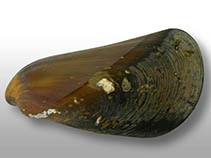Mytella bicolor (Bruguière, 1792)
Guyana swamp mussel| Native range | All suitable habitat | Point map | Year 2050 |

|
| This map was computer-generated and has not yet been reviewed. |
| Mytella bicolor AquaMaps Data sources: GBIF OBIS |
Classification / Names Common names | Synonyms | CoL | ITIS | WoRMS
Bivalvia | Mytilida | Mytilidae
Environment: milieu / climate zone / depth range / distribution range Ecology
Benthic. Tropical; 30°N - 29°S, 114°W - 34°W
Distribution Countries | FAO areas | Ecosystems | Occurrences | Introductions
Eastern Central Pacific and Western Atlantic: Mexico and Southern Caribbean to southeast Brazil.
Length at first maturity / Size / Weight / Age
Maturity: Lm ?, range 2 - 4.296 cm Max length : 7.0 cm SHL male/unsexed; (Ref. 83435); common length : 9.0 cm SHL male/unsexed; (Ref. 344)
Short description Morphology
Shell mussel-shaped, elongate, ventral region concave. Oblique ridge runs anterodorsal to posteroventral region of valve. Umbones subterminal. Posterior part of the mantle with branching tentacles. Colour: externally greenish on posterodorsal region (above ridge) and yellowish brown on anteroventral region (below ridge).
Intertidal in bays and protected areas, forming clumps attached to mangrove prop roots or other hard substrates (Ref. 344) via its byssus (Ref. 104222). Attached to mangrove roots, particularly on Rhizophorae mangle (Ref. 104222). Some found to be buried in substrate. Also occurs in a river estuary. Highly tolerant to salinity variations (Ref. 104223). Parasitic on this mussel are Rickettsia-like organisms, Apicomplexa and Platyhelminthes (Ref. 104222). In general, suspension feeding bivalves mainly depend on phytoplankton and detritus material for nutrition (Ref. 107088).
Life cycle and mating behavior Maturity | Reproduction | Spawning | Eggs | Fecundity | Larvae
Life cycle: Embryos develop into free-swimming trocophore larvae, succeeded by the bivalve veliger, resembling a miniature clam (Ref. 833).
Main reference
References | Coordinator | Collaborators
Leal, J.H. 2003. (Ref. 344)
IUCN Red List Status (Ref. 130435)
CITES status (Ref. 108899)
Not Evaluated
CMS (Ref. 116361)
Not Evaluated
Threat to humans
Harmless
Human uses
Fisheries: commercial
| FishSource |
Tools
More information
Internet sources
BHL | BOLD Systems | CISTI | DiscoverLife | FAO(Publication : search) | Fishipedia | GenBank (genome, nucleotide) | GloBI | Gomexsi | Google Books | Google Scholar | Google | PubMed | Tree of Life | Wikipedia (Go, Search) | Zoological Record
Estimates based on models
Preferred temperature
(Ref. 115969): 24.9 - 28.7, mean 27.3 (based on 614 cells).



